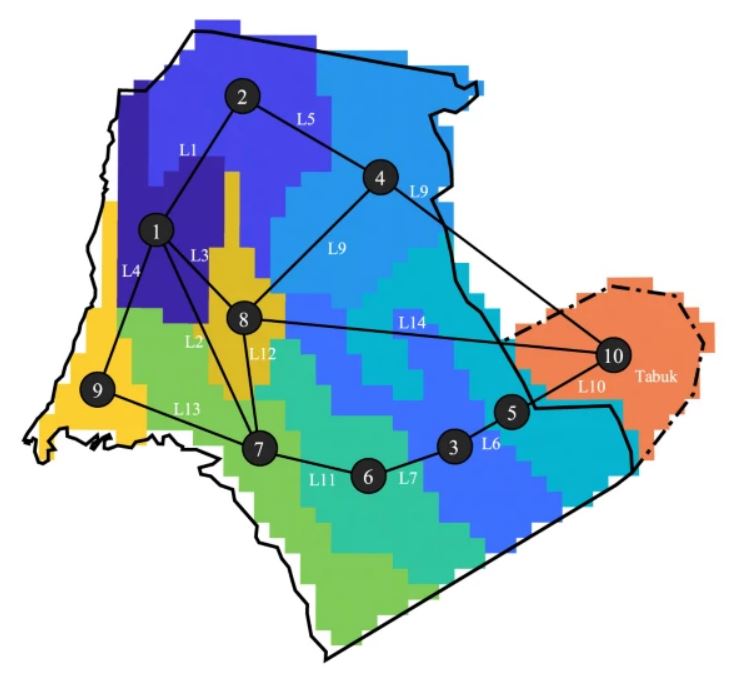Neom City is a futuristic city that the Saudi Arabian government plans to build in the country's Tabuk region. The $500 billion development will include a range of smart technologies and will serve as a “living laboratory and hub for innovation,” according to its planners. It will also be exclusively powered by renewable energy.
According to a new study by King Abdullah University of Science and Technology (KAUST), renewables-powered desalination will play a key role in the city. It will be critical to ensuring sustainable supplies of water through demand-side management (DSM).
“This work proposes a multi-period (2020–29) generation and expansion planning co-optimization model for a system that considers investment and operation decisions for the power and water sectors under uncertainty,” the scientists said. “The model accommodates a high penetration of renewable energy sources and introduces flexibility through water storage, batteries, and DSM.”
Their model was based on a 4 GW transmission connection to the existing Saudi Arabian electricity network. They assessed the costs and added flexibility to the power-water coupled system. They also divided the city into nine nodes and considered four generating technologies: combined cycle gas turbines (CCGT), photovoltaics (PV), concentrated solar power (CSP), and onshore wind turbines, as well as battery storage and hydroelectric pumped storage (HPS).
“We consider constructing 14 possible transmission lines with a nodal balance to ensure that supply meets demand,” they said, adding that they assumed reverse osmosis (RO) desalination and water storage tanks as the main technologies for the desalination facilities. Renewables-powered desalination is expected to account for around 20% of Neom's total electricity consumption.
The Saudi team presented four business cases. They considered a desalination system powered exclusively by solar-plus-storage (PV only), as well as a system based on wind-plus-storage (wind Only). They also looked at a system based on different renewable energy sources, including concentrated solar power (CSP) and no CCGT, as well as a system that could rely on the existing connection with the Saudi network. For every case, they used independent approaches, under which the power and water sector investments would be planned separately, and co-optimized approaches, where the two sectors would cooperate.
The second approach showed the biggest cost savings for the power sector, as it allows for shaving peak demand by shifting necessary power consumption by the water sector.
Popular content
“The savings are greatest for the ‘wind only' and ‘PV only' cases,” the academics said. “For these cases, the generating capacity is significantly greater than the power demand at any given hour because these systems must generate enough electricity to meet demand and battery storage for future use.”
The “PV only” case resulted in a substantial increase in total desalination capacity. The co-optimized “PV only” model required nearly 41% more RO desalination capacity than the independent strategy. There was also a 4% increase in water storage capacity, the Saudi group explained. Despite the increase in costs for the water sector, the total costs of the entire system decreased for all cases, they noted.
The levelized costs of energy of the “PV only” case was found to be $47.90/MWh, while that of the “wind only” case was $134.07/MWh.
“Co-optimizing the two sectors resulted in a 4% and 7% decrease in LCOE for the respective cases. By understanding water production patterns, capacity investment or power spillage can be decreased, which reduced the LCOE,” the academics said. “Analysis results suggest that systems with higher shares of non-dispatchable renewables experience the most significant cost reductions.”
They introduced their findings in “Simulated co-optimization of renewable energy and desalination systems in Neom, Saudi Arabia,” which was recently published in Nature Communications.
“The results obtained for Neom may provide insights into other systems with similar climates, renewable resource availability, or a need for desalination,” they said. “These regions include the Southwestern region of the United States, parts of Australia, Chile, South Africa, and the MENA region.”
This content is protected by copyright and may not be reused. If you want to cooperate with us and would like to reuse some of our content, please contact: editors@pv-magazine.com.



I need more knowledge on renewable energy source please.